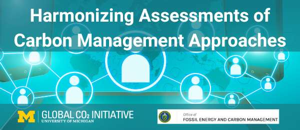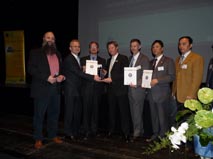 |
| Presentation WPC Award |
The demand for wood plastic composites (WPC) is increasing despite the present economic crisis. The Third German WPC Congress in Cologne took place on the 2nd and 3rd of December 2009. With 300 participants from 26 countries and 30 exhibitors, it continues to establish itself as the leading European congress for the WPC industry. During this latest event, STAEDTLER was awarded the WPC Innovation Award 2009 for its WOPEX pencil.
Producers, mechanical engineers and additive producers came together in Cologne to exchange information and discuss the latest market developments and technical trends. Besides developments in the German-speaking areas, the focus of the congress this year was on China. A Chinese delegation introduced the Chinese WPC industry in its own individual session.
Today more than 1.5 million tons of WPC are produced worldwide, especially in North-America (about 1 million tons), China (200,000 tons) and Japan (100,000 tons). Germany is the European leader with more than 70,000 tons and is, in addition, the leader in machine engineering. In Germany the main areas for the application of WPC are in the automotive industry for car interiors and also in deckings. Deckings are floor coverings, used mainly in outdoor areas, such as terraces and public places. These deckings are increasingly becoming an alternative to tropical timber, and sales volume shows a yearly double digit growth.
Representatives from industry and research presented many new applications. These innovations, for example concrete formwork boards, container floors and facing panels, will achieve substantial growth in the next few years.
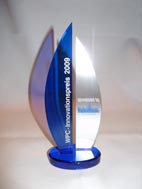 |
| WPC Innovation Award 2009 |
The application of WPC in China is even more extensive. The Chinese production includes products such as windows, doors, thermal insulating systems, park benches, garden sheds and sun screens for tower buildings, all made from WPC. Raw materials are wood flour as well as other cellulosic agricultural byproducts. The growth in China is at a level of 30% per year. Chinese WPC production is predicted to increase by up to 5 million tons per year between now and 2015.
A special highlight of the congress was the WPC Innovation Award for new developments within the WPC sector. 15 companies, which had introduced new WPC products in 2009, applied for the WPC Innovation Award 2009 which was sponsored by Reifenhäuser GmbH & Co. KG, Troisdorf, Germany. A jury of sponsors, congress partners and Nova-Institut staff nominated three companies. These companies introduced their products in short presentations. Afterwards the winner was elected by the conference audience:
WPC Innovation Award 2009: The first pencil made from WOPEX
The reinvention of the pencil from the stable of STAEDTLER Mars GmbH & Co. KG, Nürnberg, Germany.
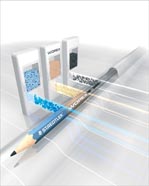 |
| WOPEX Pencil (© Staedtler) |
The conference audience was most impressed with WOPEX and chose this as the winning product. The new WOPEX pencil certainly has a lot to offer. The pencil shaft is made from a wood plastic composite (WOPEX WPC) with a wood content of 70%. The material consists of fine wood fibre from PEFC-certified German saw mill residue. The pencil lead is made up of appropriate graphites with the addition of very brittle plastics and stearates (soaps) instead of the conventional mixture fired from clay and graphite. The surface consists of a polymer composite from thermoplastic elastomers (TPEs) and polyofines to give it a smooth texture, making it pleasant to handle. All materials are fused at temperatures of 130 – 180 °C. Afterwards they are fed to a co-extrusion head that was specially developed by the company. The single melt flows are directed towards each other in the co-extrusion head, which gives the right volume and the correct positioning. The production process is not only interesting from the technical point of view but also has a number of advantages. Compared to the production of conventional pencils, the production process is much shorter. In addition, the use of wood as a raw material is much more efficient (for conventional pencils the wood waste is up to 80%) and less energy is required. There are also many benefits for customers: the look and feel is of a high-quality, the writing flow of the pen has a waxy glide which leaves almost no particle residue
on the page. Furthermore, it lasts almost twice as long as comparable wood-cased pencils.
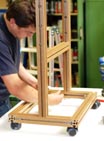 |
| Hiendl Assembly Profile (© Hiendl) |
Second-prize winner: the assembly profile system from Hiendl GmbH & Co. KG, Bogen, Germany.
As an alternative to standard metal profiles H. Hiendl GmbH & Co. KG offers a variety of assembly profile systems that are made from the composite material Hiendl NFC® with a wood content of 70%. In comparison to conventional metal systems, the profiles of Hiendl can be continuously extruded in colour.
Because of the high-quality composite material and the greater thickness of the material in comparison to metal profiles, the Hiendl profiles are as robust as conventional solutions. They are compatible with conventional systems and are lower-priced than aluminum profiles.
 |
| WPC Thermal Insulated Siding (© QVWPC) |
Third-prize winner: the WPC thermal insulated siding from Quingdao HuaSheng
Hi-tech Development Co.Ltd., China
This Chinese company offers WPC facing elements with integrated XPS-insulation. They can be extruded in multiple colours and are already used extensively in house facings.
Further Information:
All presentations of the Third German WPC Congress are available on CD ROM and can be ordered for 100 € plus 19% VAT from the nova-Institut at: http://bio-based.eu/proceedings/
Click here for a PDF file of the press release.
Source
nova-institut GmbH, press release, 2009-12-03.
Supplier
Hiendl Kunststofftechnik GmbH & Co. KG
nova-Institut GmbH
Qingdao HuaSheng Hi-tech Development
Reifenhäuser EXTRUSION Technology GmbH & Co. KG
Staedtler Mars GmbH & Co. KG
Share
Renewable Carbon News – Daily Newsletter
Subscribe to our daily email newsletter – the world's leading newsletter on renewable materials and chemicals






